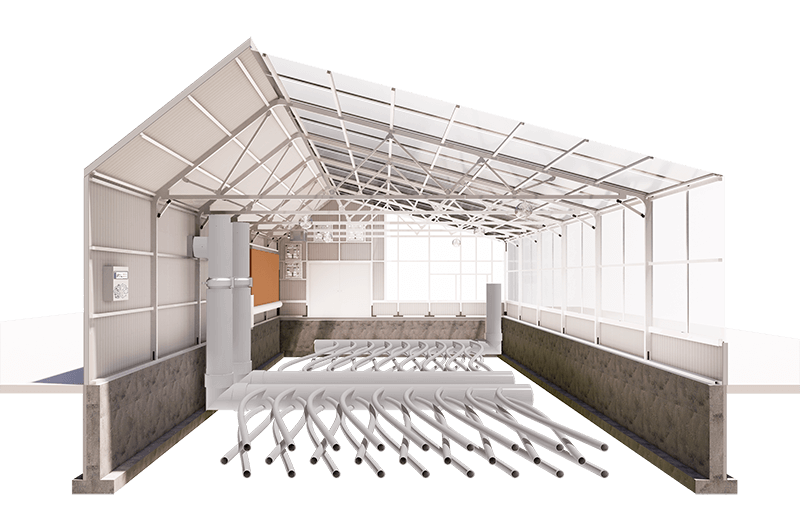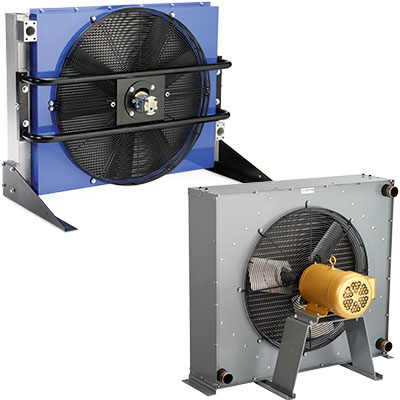How DVS Heat Transfer Systems Are Driving Sustainability Trends in Thermal Engineering
Wiki Article
A Comprehensive Overview to Choosing the Right Heat Transfer Systems for Your Requirements
Picking the proper Heat transfer system is essential for operational effectiveness. Different systems cater to various demands, affected by aspects such as temperature array and fluid type. Recognizing the principles behind Heat transfer, such as conduction, convection, and radiation, is critical. Additionally, evaluating power resources and upkeep practices can influence long-term efficiency. A closer examination of these considerations exposes how to customize a system to details needs. What should one prioritize in this complicated decision-making process?Comprehending Heat Transfer: Key Concepts and Principles
Although Heat transfer might look like a straightforward principle, it encompasses a variety of concepts that are essential for reliable system layout. Comprehending these concepts is essential for designers and developers that aim to optimize thermal performance in various applications. Transmission, as an example, includes the transfer of Heat via strong products, while convection describes the movement of Heat within fluids. Radiation, one more crucial concept, describes how Heat can be transferred with electromagnetic waves. Each of these mechanisms plays an important duty in determining just how power moves within a system. By thoroughly understanding these ideas, experts can make informed choices, ensuring that Heat transfer systems run efficiently and fulfill the specific needs of their applications
Sorts Of Heat Transfer Systems: An Overview
Recognizing the principles of Heat transfer lays the groundwork for discovering the various types of Heat transfer systems readily available. Heat transfer systems can be classified primarily right into three kinds: transmission, radiation, and convection. Conduction involves Heat transfer through strong products, relying on direct get in touch with in between bits. Convection, on the various other hand, happens in fluids (gases and liquids) where the activity of the liquid itself promotes Heat transfer. Radiation entails the transfer of Heat through electro-magnetic waves and does not need a tool, allowing it to take place in a vacuum. Each kind of system has unique features and applications, making it important for people and organizations to thoroughly assess their specific needs when picking the most ideal Heat transfer option.Applications of Heat Transfer Systems in Numerous Industries
Heat transfer systems play a vital function throughout different sectors, impacting efficiency and item top quality. In commercial production processes, they help with specific temperature control, while in food and beverage handling, they ensure security and conservation. Furthermore, HVAC and environment control systems depend heavily on effective Heat transfer to keep comfortable settings.Industrial Production Processes

Numerous industrial production processes count greatly on effective Heat transfer systems to maximize productivity and enhance product high quality. In markets such as metalworking, Heat exchangers play a crucial role in preserving optimal temperature levels during welding, spreading, and forging. These systems assure consistent Heat distribution, which is vital for attaining wanted material residential properties. In the chemical manufacturing industry, Heat transfer systems assist in precise temperature control during reactions, impacting return and safety. Moreover, in fabric production, efficient Heat management is crucial for dyeing and completing processes, influencing shade uniformity and material high quality. By choosing suitable Heat transfer innovations, suppliers can boost energy performance and lower operational prices, ultimately bring about a more affordable and sustainable manufacturing atmosphere.
Food and Drink Handling
Reliable Heat transfer systems are equally essential in the food and beverage processing sector, where maintaining perfect temperature levels is vital for food security and high quality. These systems play a vital function in procedures such as cooking, pasteurization, and sterilization, ensuring that products are safe for intake and keep their nutritional worth. Heat exchangers, as an example, efficiently move Heat in between liquids, optimizing power usage while lessening temperature level variations. Furthermore, refrigeration systems are fundamental for protecting disposable products and extending shelf life. The selection of Heat transfer technology straight affects operational efficiency and item stability, making it necessary for food and drink suppliers to select the appropriate systems tailored to their certain processing needs. This careful choice ultimately contributes to customer complete satisfaction and food safety and security.
Cooling And Heating and Climate Control
While lots of markets depend on Heat transfer systems for effectiveness, HVAC (Home Heating, Air Flow, and A/c) plays an important duty in maintaining indoor environment control across various setups. These systems use Heat transfer principles to regulate air, moisture, and temperature level high quality, making sure comfort and security in property, i thought about this commercial, and industrial environments. Properly made HVAC systems enhance power efficiency, reduce operational costs, and decrease environmental influence. In commercial buildings, as an example, reliable climate control contributes to employee performance and client satisfaction. In commercial applications, heating and cooling systems help maintain perfect problems for equipment procedure and item preservation. Choosing the appropriate Heat transfer system is essential for conference specific climate control demands and achieving general system efficiency.Evaluating Power Resources for Heat Transfer Solutions
In examining energy sources for Heat transfer systems, a contrast of renewable power alternatives and nonrenewable fuel source considerations is crucial. Renewable sources, such as solar and wind, deal sustainable options that can lower ecological impact. On the other hand, nonrenewable fuel sources stay common because of their established framework and energy thickness, triggering a cautious analysis of both options.Renewable Resource Options

Nonrenewable Fuel Source Considerations
Reviewing fossil gas considerations is crucial for the efficiency and sustainability of Heat transfer systems. Fossil fuels, such as natural gas, oil, and coal, are traditional power resources that provide substantial Heat result, making them preferred options for domestic and industrial applications. Their ecological influence, consisting of greenhouse gas exhausts and resource deficiency, elevates problems. When selecting a heat transfer system, it is important to assess the availability, cost, and regulatory variables connected with these fuels. Furthermore, the effectiveness of fossil fuel systems need to be thought about, as greater performance can minimize some ecological disadvantages. Ultimately, a balanced strategy weighing efficiency and sustainability can lead decision-makers towards one of the most proper Heat transfer solution for their particular demands.Factors to Think About When Choosing a Warm Transfer System
Selecting a proper Heat transfer system needs mindful consideration of numerous aspects that can significantly impact effectiveness and efficiency. One essential element is the operating temperature range, which dictates the products and style ideal for the application. In addition, the kind of fluid used in the system-- whether gas or liquid-- affects Heat transfer performance and compatibility. The system's size and capability need to straighten with the particular requirements of the operation to stay clear of inadequacies. Power source availability is also necessary, affecting operating expense and sustainability. The installation environment, consisting of space restrictions and ease of access for maintenance, plays a substantial duty in system option. Governing conformity and safety and security requirements must be taken into consideration to ensure the system satisfies all lawful demands.Maintenance and Efficiency Optimization for Heat Transfer Equipments
Maintaining Heat transfer systems is important for ensuring optimal performance and longevity. Regular upkeep tasks, such as cleaning up Heat exchangers and evaluating insulation, aid prevent effectiveness losses as a result of fouling and thermal connecting. Additionally, monitoring system specifications, including stress and temperature, enables early discovery of abnormalities, decreasing downtime and costly repair services. Executing a precautionary upkeep schedule can optimize efficiency and prolong the life expectancy of parts. In addition, upgrading to sophisticated control systems can boost functional performance by adjusting to differing conditions and lots. By prioritizing maintenance and effectiveness optimization, drivers can achieve lowered energy usage, lower operational expenses, and boosted overall system integrity, ultimately resulting in far better source use and an extra lasting operation.Future Trends in Heat Transfer Technologies
As sectors increasingly prioritize sustainability and energy performance, future patterns in Heat transfer modern technologies are established to go through considerable transformations. Developments such as sophisticated materials, including carbon nanotubes and nanofluids, promise boosted thermal conductivity and performance. Furthermore, the integration of eco-friendly power sources right into Heat transfer systems is obtaining momentum, promoting environmentally friendly services. Smart innovations, including IoT sensors, are expected to revolutionize surveillance and control, allowing real-time data analysis for optimized efficiency. The development of modular and compact systems will certainly promote much easier installation and upkeep, providing to varied applications. These innovations suggest a change towards more lasting, efficient, and adaptable Heat transfer solutions, straightening with global energy objectives and ecological criteria.
his response
Often Asked Questions
What Are the Environmental Influences of Heat Transfer Solutions?
The environmental influences of Heat transfer systems can include greenhouse gas exhausts, energy consumption, and possible thermal pollution. Furthermore, inappropriate disposal of materials and inefficiencies can add to source exhaustion and community interruption.How Do I Determine the Cost-Effectiveness of a Warmth Transfer System?
To calculate the cost-effectiveness of a warm transfer system, one have to evaluate preliminary prices, operational expenses, upkeep needs, and power effectiveness, contrasting these factors against the anticipated lifespan and efficiency of the system.Can Heat Transfer Equipment Be Used in Residential Setups?
Heat transfer systems can indeed be used in household setups. They provide efficient home heating and cooling down solutions, making homes more comfy while potentially decreasing energy costs. Their adaptability enables various applications in domestic atmospheres.What Security Laws Relate To Heat Transfer Systems?
Security guidelines for Heat transfer systems commonly consist of standards on maintenance, operation, and installation. Compliance click now with neighborhood building regulations, producer requirements, and sector criteria is crucial to guarantee secure and efficient system performance in various applications.Just How Do Different Products Affect Heat Transfer Efficiency?

Conduction, for instance, includes the transfer of Heat via strong products, while convection refers to the activity of Heat within liquids. Recognizing the principles of Heat transfer lays the foundation for discovering the numerous kinds of Heat transfer systems readily available. Heat exchangers, for circumstances, effectively move Heat in between fluids, enhancing energy use while decreasing temperature level variations. In examining energy sources for Heat transfer systems, a comparison of eco-friendly power choices and fossil fuel considerations is crucial. Metals, such as copper and aluminum, conduct Heat properly, whereas insulators like rubber and glass reduce down Heat flow.
Report this wiki page